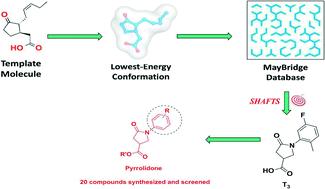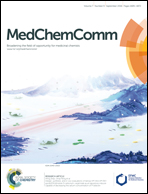The discovery of new plant activators and scaffolds with potential induced systemic resistance: from jasmonic acid to pyrrolidone†
Abstract
Plants can develop multifaceted system resistance as a result of infection with pathogens, insects, and some specific microbes or after treatment with specific chemicals.1 Among them, systemic acquired resistance (SAR) and induced systemic resistance (ISR)2 are the two most important types. To activate them, a large number of chemical inducers have been exploited based on the SA pathway. However, the JA pathway was rarely investigated for new plant activators. In this study, starting from JA and its analogs, based on the molecular three-dimensional shape and pharmacophore similarity comparison (SHAFTS), a new lead compound, pyrrolidone, as a new scaffold of plant activators was predicted and a series of 1-phenyl-5-pyrrolidone-3-carboxylic acid derivatives were designed and synthesized. The bioactivity was evaluated, and most of the compounds showed satisfactory activity; especially, compounds 7–11 showed almost no in vitro activity but excellent efficacy against tested diseases, and the prediction of the virtual screening results was also confirmed, which promoted the application of SHAFTS in the development of pesticides.


 Please wait while we load your content...
Please wait while we load your content...